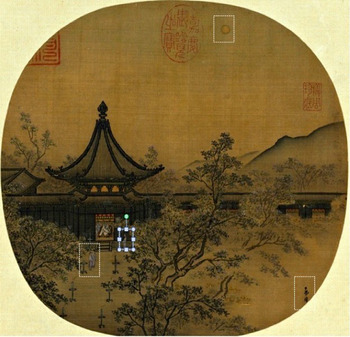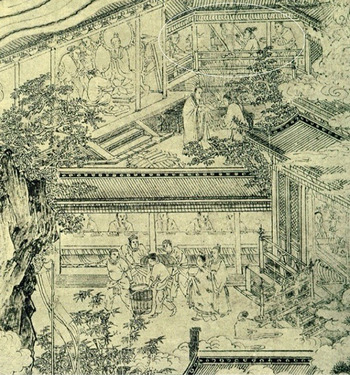Recent scholarship refutes a longstanding assumption that there existed a single, unified painting academy in Southern Song China (1127–1279).Footnote 1 These studies argue that after the collapse of the Northern Song period (960–1127), the new government in the south failed to reinstitute the imperial art school that had flourished as the Hanlin Painting Academy (abolished in 1125).Footnote 2 Instead, due to constant military attacks, financial strain, and infrastructural changes, the new regime in the capital Lin'an (modern Hangzhou) deployed painters in two ways based on the artists’ proximity to the emperor: (1) prominent painters favored by the emperor had access to the palace and passed on their court-painter status to their sons; and (2) secondary artisans were assigned to governmental bureaus to decorate murals and objects.Footnote 3 This framework explains the pragmatic nature of the Southern Song court—saving on institutional costs by using ad hoc arrangements to license summoned painters. Except for the fortunate first category, the majority of painters were distributed across governmental sectors (Figure 1). Although Southern Song accounts never gave the various substitutes a fixed name (huayuan 畫院 or related terms), post-Song historiography imagined that all artists worked at a “Painting Academy,” one that was glorified in the former Northern Song as a single headquarters with mansions to accommodate all the court painters.

Figure 1. Map of West Lake. Qian Shuoyou 潛說友 (1216–1277), Xianchun Linan zhi 咸淳臨安志 (Local Gazetteer of Lin'an in the Xianchun Region; 1268), in Song Yuan fangzhi congkan (Collection of Local Gazetteers of the Song-Yuan Periods) (Beijing: Zhonghua shuju, 1990), 1.9
A: Imperial Way 御街
B: Lane of Famous Fans 聞扇子巷
C: Lin'an prefectural office
D: Qingbo Gate 清波門
E: Empress dowager Yang's mansion
To complement the previous framework, the present article proposes a third category: freelance painters,Footnote 4 who have been misunderstood as court painters but who mostly ran fan-shop businesses in the streets of the capital. This type of painter did not even belong to the imperial employment system, but they were provisionally contracted by the court on an as-needed basis.Footnote 5
I explore the career and art of this underexamined contingent workforce in several steps. By defining how freelance artists provided a different type of service than regular court painters, I contextualize art and labor in the larger Lin'an bureaucratic system. I then delve into the case of Chen Qingbo 陳清波 (act. 1210–1260), who historiographers have mischaracterized as a court painter but who I argue was in fact a freelance fan painter. Stylistic analysis enables me to identify several fan paintings as products of Chen's workshop. Based on these identifications, I explore his fan shop location, compositional modules, and potential customers, in order to flesh out a picture of the world of self-supporting artists in Lin'an.
To bring this world into focus, I widen my lens to include other freelance fan painters, examining how they made a living by multitasking, mutual plagiarism, and sometimes inscribing their signatures in two locations on the same fan to prevent forgery. I argue that, throughout the entire Southern Song, many fan-shop painters joined craftsmen guilds,Footnote 6 which introduced their members to customers including the royal families and the Lin'an government. While modern scholars have tended to assume that the surviving Southern Song fan paintings were executed by court painters, the discovery of the freelance group suggests that at least some fans were produced by non-court painters in Lin'an.
These findings, which have been overlooked by previous scholarship, raise questions about the sociopolitical and economic contexts of freelance painters: without a secure official wage, how did they circumvent labor abuse by the emperor? How did these presumably vulnerable individuals gain artistic training, compete with privileged court painters, and steal each other's designs in a fierce market? What power did the emperor exercise over the outsiders, and what role did profit play in the court's gatekeeping function? By investigating the patron-client relationship of each party, I propose that the Southern Song court, under the guise of giving artists autonomy, allowed market agents (e.g. brokers and guilds) to negotiate with the court about the benefits enjoyed by freelance painters.Footnote 7 The legal protection that freelancers found by joining a craftsmen guild facilitated class mobility between court painters and outsiders. Ultimately, the commercial society of Southern Song Lin'an changed the ways in which regimes recruited and deployed artists in later dynasties, a watershed moment in the history of the Chinese painting academy.Footnote 8
Defining Freelance Painters: a Hidden Class Misidentified as Court Painters
A major challenge for Southern Song court painters was that there was no physical painting academy where they could work. Previously, at the Northern Song court, Emperor Huizong (r. 1100–1126) had assembled his court painters in a specific, centralized headquarters where they received rigid training and supervision.Footnote 9 Court painters specializing in fan painting were periodically dispatched to serve the academy or the Crafts Institute 文思院, an imperial workshop bureau which oversaw 3,000 craftsmen in 32 governmental studios, including the Fan Studio 扇子作.Footnote 10
After the governmental relocation to Lin'an, however, neither the painting academy nor the Fan Studio was reestablished. The Crafts Institute now relied more on non-court painters, who could share the manufacturing duties with its formal employees to produce ceremonial objects (e.g. embroidered clothes, vessels).Footnote 11 Without a headquarters to convene court- and non-court painters to serve the emperor, how exactly did the Southern Song emperor muster artists dispersed across four regions? How did freelance painters, when summoned, differ from regular court painters?
By regular court painter (c.p.), I refer to master artists who served the emperor directly and received benefits from the court—e.g. honorary titles, golden belts, and monthly wages—as emblems of their courtly status. Yan Ciping 閻次平 (c.p. 1162–1180s), Li Song 李嵩 (c.p. 1166–1243),Footnote 12 Ma Yuan 馬遠 (c.p. 1194–1233),Footnote 13 Xia Gui 夏珪 (c.p. 1180–1240) and their lineages belonged to this category.Footnote 14 As the emperor's personal servants, these imperial favorites styled themselves as yuqian 御前 painters (literally, “painters before the throne”),Footnote 15 and had access to the palace night and day on a rotating schedule (Figure 2). Trusted by the throne, the masters were able to recommend their sons as yuqian painters as well, bypassing the official exams and establishing dynasties of elite painters. Each family taught its own members privately. Over the course of the Southern Song period, at least thirteen court-painter lineages can be reconstructed. Table 1 enumerates four major clans that existed during the reigns of Emperors Ningzong (r. 1195–1224) and Lizong (r. 1224–1264). Evidently, the monarch preferred to hire painters from whom he was already acquainted.
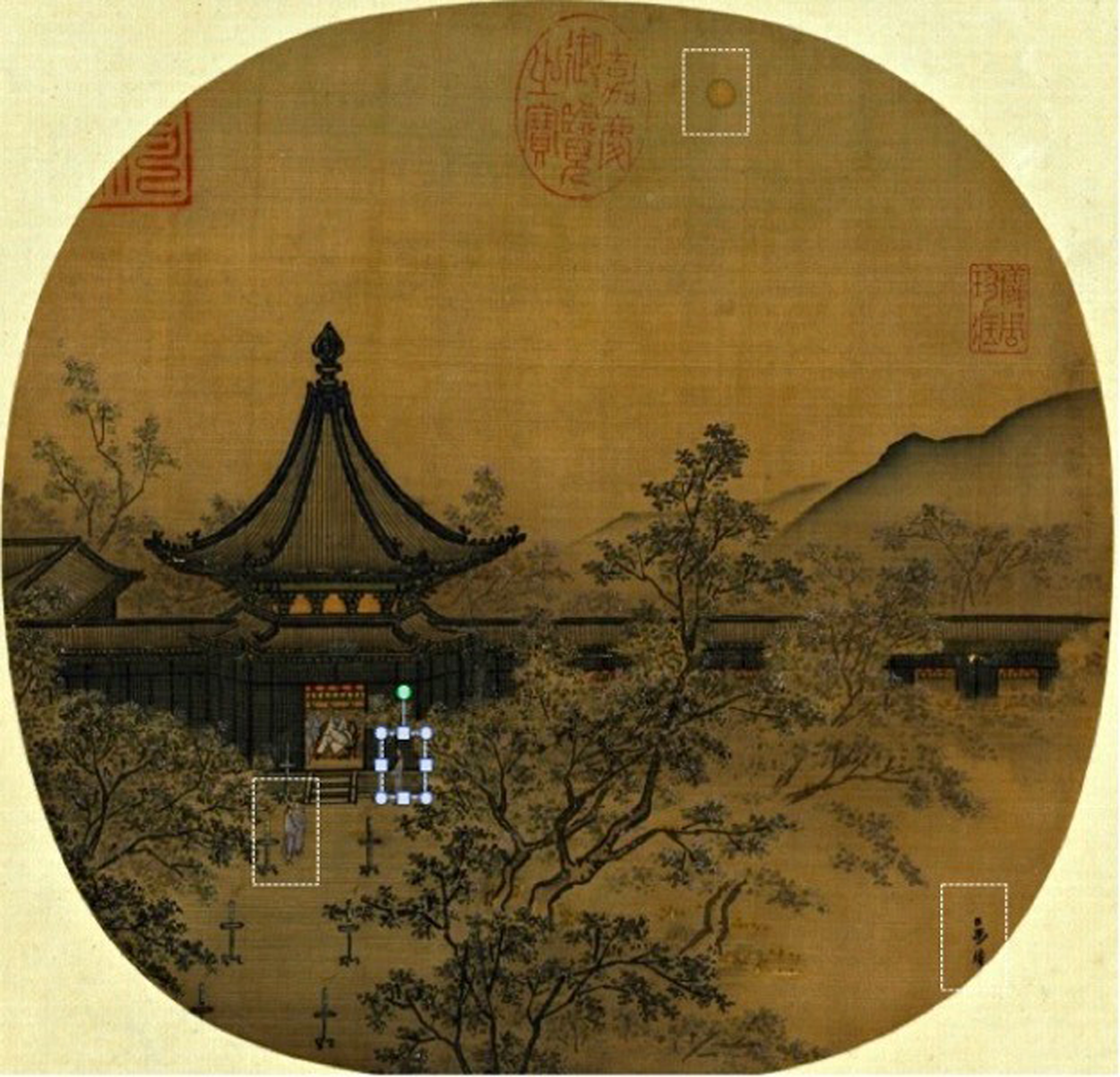
Figure 2. Ma Lin 馬麟 (ca. 1195–1264), Night Stroll by Lamplight 秉燭夜遊圖. Signature: “Your servitor, Ma Lin.” Fan, ink and colors on silk, 24.8 × 25.2 cm. National Palace Museum, Taipei
Table 1. Yuqian court painters whose lifetimes overlapped with Chen Qingbo'sFootnote 16

Yuqian court painters attended the emperor, thus constituting the core of what art historians have traditionally canonized as the “Southern Song painting academy.” If satisfied, the emperor would tip them in cash upon completion of a project.Footnote 18 Their honorary titles (e.g. Gentleman for Fostering Uprightness in the 8b rank) had no relation to their actual duties, but allowed them to be integrated into the state's nine-rank system, which determined their salaries.Footnote 19 Their yuqian court-painter status would grant them governmental access, a way to enter the bureaucracy, while awaiting possible promotions through regular official channels.
Despite their career and nepotistic advantages, however, monthly salaries for yuqian painters were not very lucrative. In the nine-rank system, government officials could be elevated to the supreme 1a rank and were entitled to an annual remuneration of 100,000 coins. Yuqian painters, as “skilled practitioners” 伎藝人 who enter the bureaucracy through back door recommendation and who pleased the emperor with their artistry, could only climb the ladder from the lowest rank of 9b up to 8a.Footnote 20 Painter Xia Gui, in the highest 8a, received only 17,000 coins, while most painters remained in lower ranks, such as Yan Ciyu and Ma Gongxian in 9b, with a wage of 7,000 coins yearly.Footnote 21
In addition to painters, palace entertainers from other fields—chess players, musicians, storytellers, and dramatic performers—were all employed by the court as “yuqian practitioners.”Footnote 22 Their on-call service earned them descriptors such as daizhao 待詔 (in-attendance) or zhihou 衹候 (in-waiting).Footnote 23 These terms became interchangeable in the Southern Song, unlike the rigid hierarchy of official titles in the Northern Song.Footnote 24
Freelance painters, often referred to by the Southern Song court as market-people 市人, were contract-based artists. For exceptional events such as the death of an emperor or empress, the court paid a portraitist like Xu Que 徐確 (act. 1100–1167) to depict the deceased royal for commemoration.Footnote 25 While in the Northern Song capital Kaifeng, freelance fans were mostly sold to city shoppers,Footnote 26 in the Southern Song an increasing number of such products were sold to imperial buyers.
In Chen Qingbo's time in particular, the Lizong emperor frequently held banquets that necessitated the acquisition of painted fans as gifts for officials.Footnote 27 Another example: while constructing the Hibiscus Pavilion, Lizong in 1257 enlisted many non-court painters to aid the yuqian painters in decorating palace murals. This mode of collaboration is illustrated in yuqian painter Liang Kai's (c.p. 1201–1204) handscroll, Frontispiece to a Daoist Scripture (Figure 3), which depicts multiple artists collaborating to design artworks for a Daoist temple funded by an imperial consort.Footnote 28 The upper image in Figure 3 visualizes a Southern Song artist's experience at a workshop, where groups of artists teamed up to sketch a Daoist deity portrait and shape a sculpture. The end of the scroll bears Liang's signature “your servitor, Liang Kai,” which corroborates my argument that he indeed illustrated a scene of workshop collaboration for an imperial project. This teamwork imagery also reminds us that certain paintings in the “courtly style,” which are too often attributed to yuqian insiders, might instead have been executed by freelance outsiders.
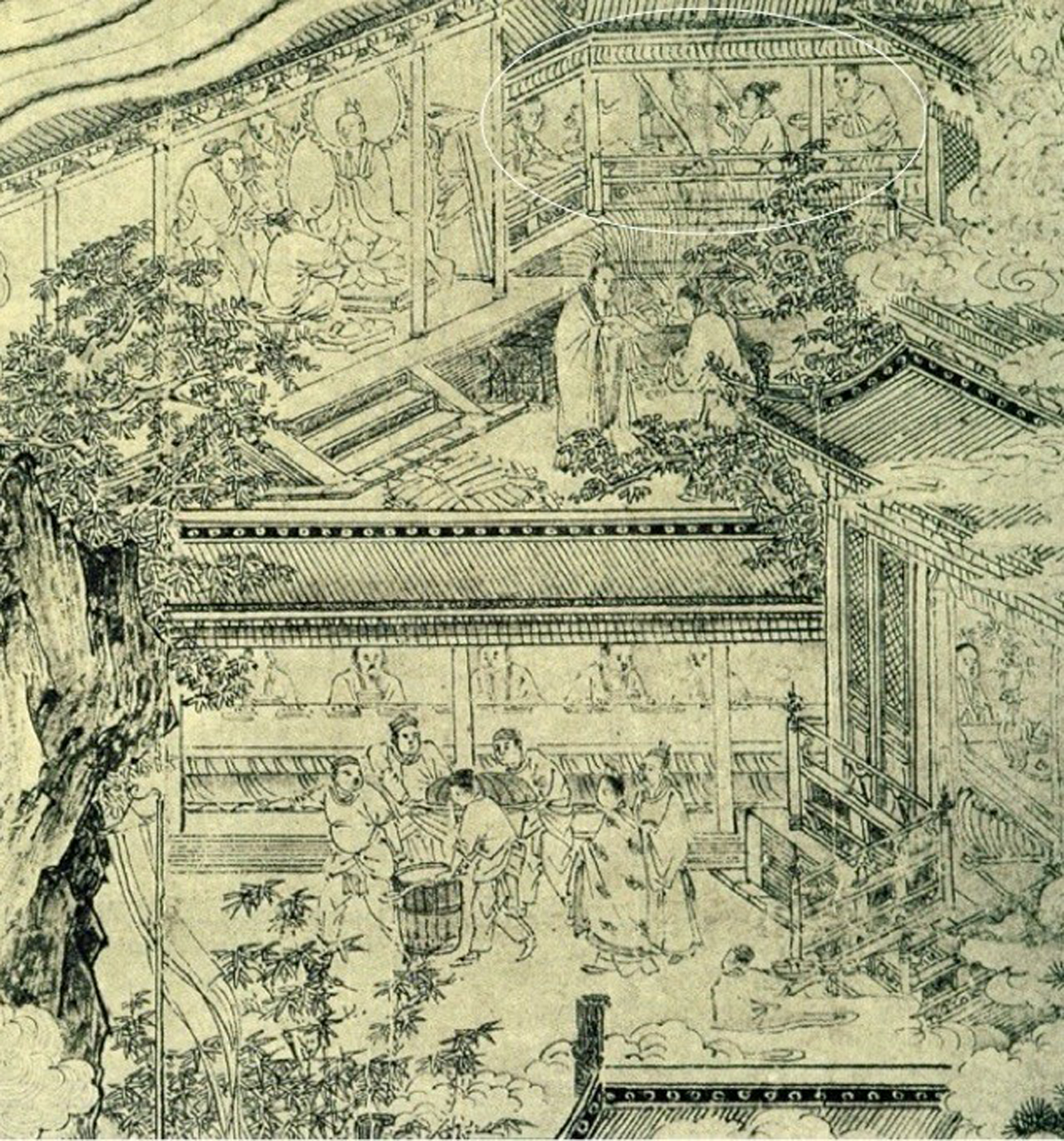
Figure 3. Detail of Liang Kai 梁楷 (c.p. 1201–1204), Frontispiece to a Daoist Scripture. Signature: “Your servitor, Liang Lai” 臣梁楷. ca. 1201–1204. Handscroll, ink on paper, 25.9 x 73.7 cm. Private Collection of Wango Weng
Existing Song accounts seldom specify the names of individual freelance painters, leaving this class under-examined by modern scholarship. Lacking literary documentation, we need to seek evidence through formal analysis of the artwork itself, in order to approximate the worldview of the freelancers. Below I group five fan paintings together in order to deduce their habitual patterns and intentions. Stylistic resemblances reveal that these fans were painted by three men from a close circle surrounding Chen Qingbo, an outsider previously obscured as an official court painter.
Identifying Fan Paintings from the Workshop of Chen Qingbo
Table 2 below inventories five fan paintings that share common traits. Each fan partitions the land into two parcels, connected through a zigzagging footpath in a 之 shape (Figures 4–8). The sides of the path were washed in a transparent green, leaving the trail blank without any pigments. Each trail contains walking figures without facial features. The shared patterns suggest that a couple of artists circulated models among themselves. Their brushwork reflects three levels of proficiency, signifying that three artists—probably masters and apprentices from the same workshop—produced the fan products.
Table 2. Reconstruction of fan paintings displaying Chen Qingbo's style


Figure 4. Chen Qingbo, Spring Dawn 春曉圖. With two signatures dated to 1235. Fan, ink and colors on silk, 25 x 26.7 cm. The Palace Museum, Beijing

Figure 5. Chen Qingbo, Palace Terrace under Moonlight 瑤臺步月圖. With two signatures (“清波作”). Fan, ink and colors on silk, 25.6 x 26.7 cm. The Palace Museum, Beijing

Figure 6. Top: Chen Qingbo, Long Bridge across a River 長橋臥波圖. Fan, ink and colors on silk, 23.9 x 26.3 cm. The Palace Museum, Beijing. Bottom: Photograph of the actual sites of Long Bridge and Leifeng Pagoda, rebuilt in 2002

Figure 7. Anonymous, Water Village and Pavilions 水村樓閣圖. Fan, ink and colors on silk, 23.5 × 23 cm. The Palace Museum, Beijing
Among these fans, Spring Dawn (Figure 4) and Palace Terrace under Moonlight (Figure 5) each carry two signatures in standard scripts. The Spring Dawn signature, which appears twice on the fan, reads, “The year of yiwei (1235), made by Qingbo” 乙未清波作,Footnote 29 while that on Palace Terrace also doubled, reads, “Made by Qingbo” 清波作. The four signatures from around 1235 demonstrate an identical calligraphy style. They are thinly written, cautiously inscribed by the same person, who wielded a small brush at a perpendicular angle. As shown in the characters qing 清, bo 波, and zuo 作, the inscriber converted horizontal lines into diverging dots to avoid repeated parallels. He tightened the center composition of each character, lifted the right shoulder of horizontal strokes, while elongating the signature's last stroke to create bony structures.
Similar hand movements appear in three paintings: Spring Dawn (Figure 4), Palace Terrace (Figure 5), and the unsigned Long Bridge across a River (Figure 6). In Long Bridge, the ripple on the lake (Figure 10) and the slim travelers (Figure 11) are gently outlined by the tip of the brush at a perpendicular angle, giving the art a soft flair. This idiosyncratic brushstroke can be seen in the signatures of Spring Dawn and Palace Terrace, as well as the lush willow leaves (Figure 12) of the paintings. In the three paintings, the mist-shrouded distant hills are speckled with tiny dots (Figure 13). Only the hilltops are contoured; their internal textures are obscured with color wash. All three fans were executed by the same artist, Qingbo, whose autographs from 1235 place him in Emperor Lizong's reign, a period of demographic and commercial expansion in Lin'an.
Who was Qingbo? The mounting board of Spring Dawn carries an external title slip by the collector Liang Qingbiao 梁清標 (1620–1691), which reads “Spring Dawn by Chen Qingbo” 陳清波春曉圖 (Figure 4). An important art aficionado who studied, remounted, and rewrote numerous title slips on Song paintings, Liang identified Chen Qingbo as the fan's painter. I accept Liang's authentication because the collector was knowledgeable about Southern Song fans, and most of his title slips are accurate.
Furthermore, the elevated bird's-eye view in these fans matches Xia Wenyan's 夏文彥 (act. 1312–1370) description of Chen Qingbo's compositional manner. In his catalogue The Precious Mirror of Painting from 1365, Xia elucidates that Chen often created spatial illusion through aerial perspective: “Chen Qingbo, a native of Qiantang, often depicted panoramic vistas of West Lake” 陳清波, 錢塘人, 多作西湖全景.Footnote 30 This 1365 testament buttresses my argument that the three surviving, signed, and dated fans were made by Chen Qingbo himself, who often depicted a panoramic vast lake on a miniature fan.Footnote 31
While Chen's contemporaries (e.g. the Ma-Xia school painters in Figure 17) imagined towering cliffs with jagged rocks, Chen opted for rounded and continuous hills, which reflected the reality of West Lake topography. Also listed in Table 2, below Chen's three authentic works are two anonymous fans by different artists: Water Village and Pavilions (Figure 7) and Scholar with Servant Carrying a Zither (Figure 8).Footnote 32 Both fans situate the white-robed scholar and his zither-carrying servant in analogous postures, in profile and without facial features (Figure 9). Adopting this compositional model, members of a workshop could effectively reshuffle formulaic units into varying layouts.
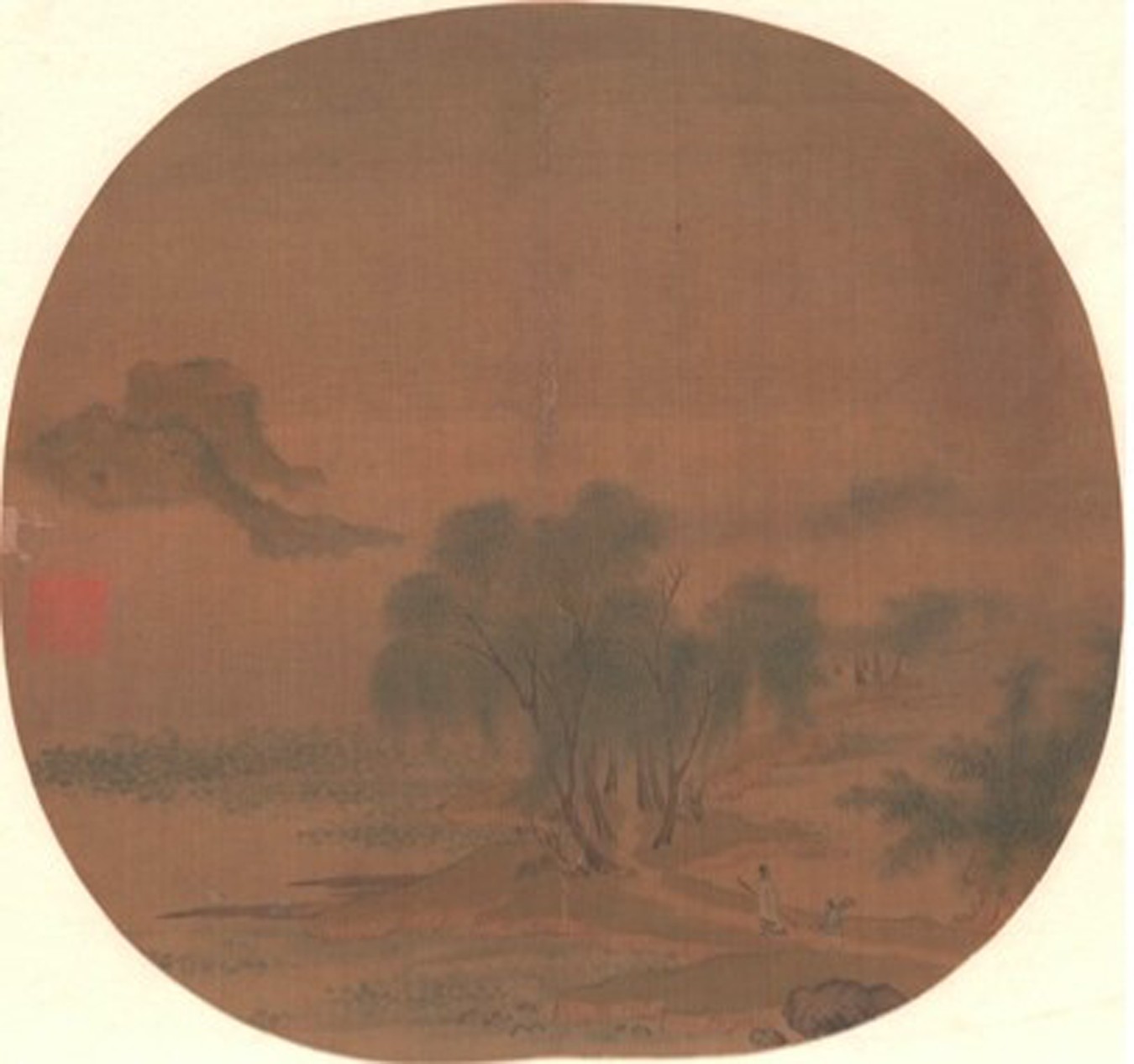
Figure 8. Anonymous, Scholar with Servant Carrying a Zither. No Chinese painting title. Fan, ink and colors on silk, 22 × 24.7 cm. The Art Institute of Chicago (accession no: #1947.533)
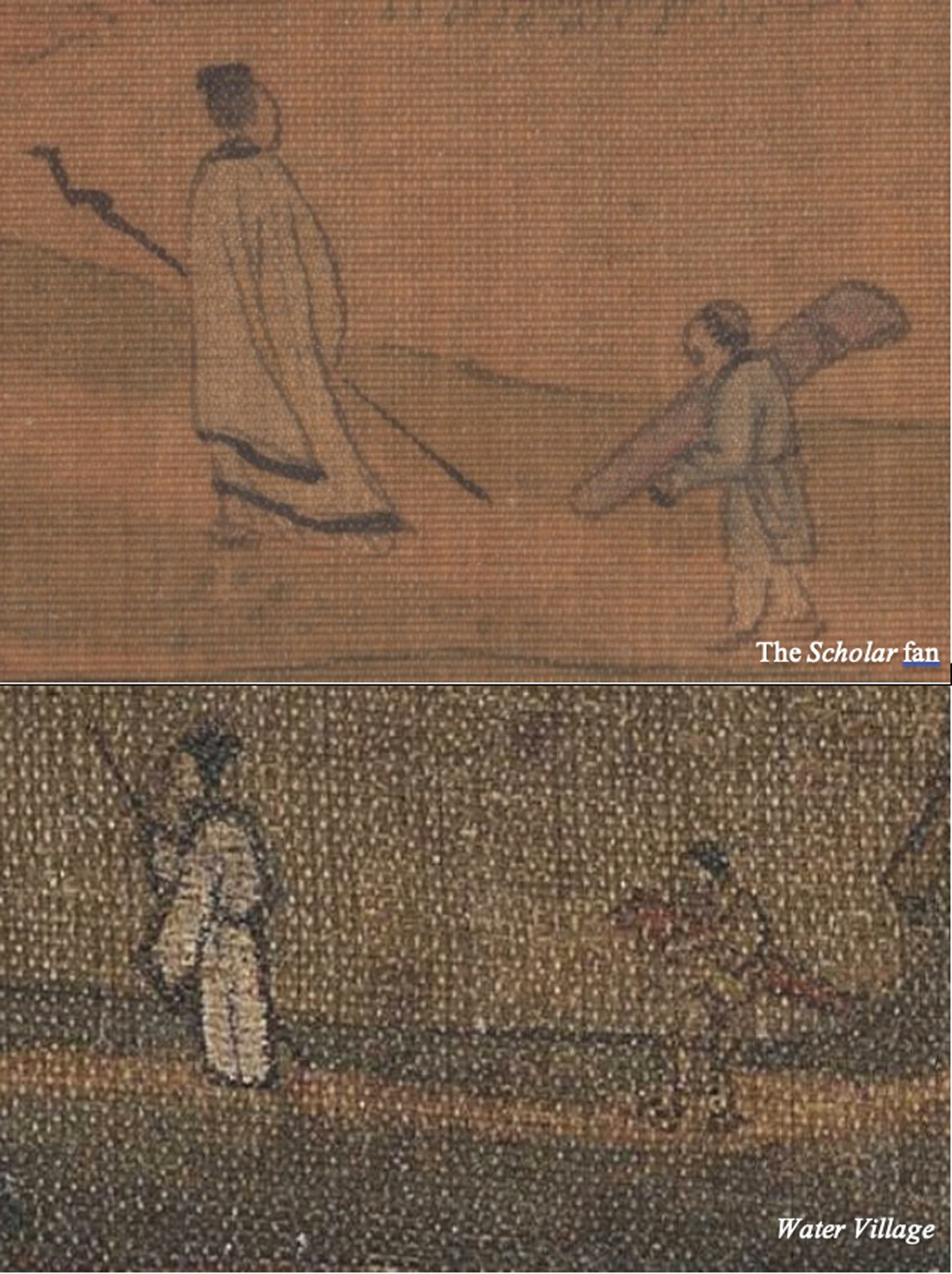
Figure 9. Top: The scholar-servant set in the Scholar fan. Bottom: Water Village (lower image).

Figure 10. Top: Depictions of land in the Scholar fan. Bottom: Chen's Long Bridge
Although the Water Village and Scholar fan are loosely associated with Chen's workshop style—raised landforms, empty facial features, central-brush movement, and rounded mountains—their brushwork treatments are different from Chen's. The stiff figures and mediocre shading in Water Village expose the rudimentary work of a novice,Footnote 33 while the exquisite Scholar fan outstrips Chen's work in the superiority of its brushwork.Footnote 34 Probably executed by a predecessor or senior master who had previously studied Zhao Lingrang's 趙令穰 (1070–1100) lakeshore motif and Yan Ciping's rock textures (Figure 16), the Scholar fan fuses two schools from earlier generations into one.Footnote 35
The notion of a constellation of fan painters mimicking multiple schools is congruent with the set-up of fan shops in Lin'an, where each emporium was customarily staffed by a mixture of tutors, pupils, and perhaps itinerant helpers. The practice of pastiche of various traditions also appears in Palace Terrace (Figure 5), Long Bridge (Figure 6), and Water Village (Figure 7), gesturing to a new normal in thirteenth-century commercial workshops.
Why Was Chen An Outsider?
Other than Chen's dated fans, very little evidence exists about this enigmatic man. Although Ming-Qing cataloguers have classified him as a court painter, clues outlined below signify that he was instead a self-employed artist depicting fans for buyers from all sociocultural strata.
Since Chen signed his Spring Dawn in 1235, his life most likely spanned the reigns of three rulers: the Ningzong emperor, his consort Yang (who reigned 1224–1233 as empress dowager),Footnote 36 and Ningzong's successor Lizong. Chen must have coexisted with two generations of court painters: that of the elder Liu Songnian 劉松年 (c.p. 1174–1224), Ma Yuan, Xia Gui, and Li Song in Ningzong's reign, as well as the descendants whom they recommended to Lizong as court painters: Ma's son Lin, Xia's son Sen, and Li Song's nephew and three trainees, as listed in Table 1. These court painters dramatized their works with angular brushstrokes, a trait that does not appear in Chen's fans.
The earliest extant textual reference to Chen appears in a painting catalogue compiled by Xia Wenyan from 1365, which does not describe Chen as a court painter. Below the entry about Chen, the catalogue introduces other names affiliated with the court:
Chen Qingbo, a native of Qiantang, often depicted panoramic vistas of West Lake 陳清波, 錢塘人, 多作西湖全景.
Qiao Zhongkui and Qiao Sanjiao, daizhao (literarily, “waiting for calls”) in the baoyou reign (r. 1253–1258) 喬鍾馗、喬三教, 寶祐年待詔.Footnote 37
In the Southern Song skilled practitioners from various fields (e.g. painters, dancers, and storytellers) might be called daizhao, if they were on call by the emperor. Yet later chroniclers from 1475,Footnote 38 1631,Footnote 39 1691,Footnote 40 and 1721Footnote 41 misinterpreted the term daizhao, treating it as a more formal, title-holding status (e.g. “painter-in-attendance”). They also conflated the two entries (for Chen Qingbo and for the Qiaos), thereby misclassifying Chen as a court painter. In fact, Lin'an writers from 1250, 1275, and 1280 characterized the Qiaos as itinerant dancers, rather than as court painters. Together with eight other members of the Qiao family, the Qiao itinerants received performance contracts from everyone, including occasional commissions from the court (daizhao for dancing).Footnote 42 Thus, Chen Qingbo should neither be characterized as the court's painter-in-attendance, nor should his role be confused with that of the Qiao dancers.
As will be discussed below, hundreds of quasi-family units resided in Lin'an, such as the Qiao family dancers and Chen's workshop colleagues. These private units often augmented their business by becoming members of a discipline-based association known as a hang guild. Hang literarily means a profession. The leader of a guild (hanglao 行老) often facilitated connections between guild members and the Lin'an court, through which process freelance painters brokered deals to sell their artworks. Because the emperor sourced art pieces from both court painters and freelance painters, Ming-Qing chroniclers could not distinguish between the two clusters.
Since contract opportunities were intermittent and temporary, freelance painters often scraped together a living by operating family-based shops to sell trendy art, such as painted fans. As an advertisement, a family's expertise was often reflected in the name of the store. A Lin'an account from 1275 identified several family shops:
Xu Maozhi's family fan shop is situated at the entrance of the Central Entertainment Quarter 中瓦子前, 徐茂之家扇子鋪
Beneath the Charcoal Bridge River is a store for fans made of thin bamboo strips 炭橋河下, 青篦扇子鋪.
Inside the Small Market Lane are shops such as “Zhou family folding fans” and “Chen family painted round fans” 小市裏 … . 周家摺疊扇鋪、陳家畫團扇鋪.Footnote 43
Inside the Cloth Market are shops for “plum and bamboo fan sheets,” and “Zhang family painted landscape fans” 衣市有 … . 梅竹扇面兒、張人畫山水畫.Footnote 44
The passage continues to list specialized fan shops, including those which produced painted fans: “intricately painted silk fans” 細畫絹畫 and “finely colored paper fans” 細色紙扇.Footnote 45 Some of the commercial fans might have been misrecognized by modern scholars as court-painter products because of their refined brushwork quality.
The aforementioned fans from Chen Qingbo's team are all in the fan format, making them portable commodities. Could Chen have worked for one of these fan stores, such as the “Chen family painted round fans,” “intricately painted silk fans,” or any other shop? Although further evidence is lacking, several hints signify that Chen strayed away from prevailing courtly tastes, supporting the likelihood that he as an outsider deviated from the court's mainstream style.
In his youth, Chen must have known his senior neighbor Liu Songnian, a court painter who resided in the same Qingbo district and was older than Chen by ten to twenty years.Footnote 46 Yet the boy Chen did not imitate Liu's style. In Lizong's reign, court painters were overwhelmingly influenced by three major lineages—those of Li Song, Ma Lin, and Xia Gui—who imbued their art with kinetic energy. The dominant Ma-Xia school chopped rocks in “axe-cut” texture strokes, while Li Song's lineage vibrantly outlined angular drapery for their figures. The robust masters twisted their hands to dramatize their artistic performance for royal audiences. Chen, conversely, did not venture into their dynamic modes; his thin signatures expose his cautious persona, perhaps less trained in calligraphy. Such timid, thin strokes commonly appear in the signatures of freelancers Zhao Daheng 趙大亨 and Zhu Weide 朱惟德 (thirteenth century), as opposed to the confident, bold signatures of Ma Lin and Xia Gui. Chen's odd stylistic reserve implies that he was essentially an outsider. If he had been a court painter, his progressive peers at the court would have rejected his conservative brush mode.
As can be detected through microscopic imaging (Figure 14), court painters often pigmented their works with monochrome ink or a higher proportion of opaque minerals, such as pure blue azurite, green malachite, or white calcium. The Chen team, however, tinted their artwork with transparent green, which mixed organic indigo blue and gamboge yellow. The transparent purple and yellow pigments in the Scholar fan (lower image of Figure 14) have almost invisible particles, a result of organic pigments dissolving into silk threads. Likewise, timber structures (Figure 11) and tree leaves (Figure 12) are delineated with light colors instead of monochrome ink, a fresh effect which anticipated European watercolor paintings.

Figure 11. Depictions of pedestrians in Chen's fan products

Figure 12. Depictions of trees in Chen's workshop products

Figure 13. Depictions of distant mountains in Chen's workshop products

Figure 14. Top: Photomicrograph of Southern Song anonymous, Lady with Female Servant in a Palace Garden. Thirteenth century. Fan, ink and colors on silk, 25 x 26 cm. The Art Institute of Chicago. Bottom: Photomicrograph of the Scholar fan. Photograph by Rachel Freeman
Chen's iconographic repertoire departed from those of the court painters, who took instructions from the throne to illustrate imperial poems. One third of Lizong's poetic inscriptions appear in Ma Lin's paintings, according to Robert Harrist.Footnote 47 These yuqian favorites signed their names with the character chen 臣 or servitor, which indicates that they painted for the throne. When they were on duty, yuqian painters joined the palace retinue or guards (Figure 2), standing at the ready for imperial assignments. At other times, painters would wait in a courtyard or the Room for Yuqian Attendants 御前應奉所,Footnote 48 spaces available to all yuqian men regardless of their professions. Due to their rotational duty, they witnessed special nighttime scenes, such as the emperor reading or banquets in moonlit palaces, which became motifs in paintings such as Ma Yuan's Banquet by Lantern Light (National Palace Museum, Taipei), Ma Lin's Night Stroll by Lamplight (Figure 2), and Ma Lin's Palace Pleasures (National Palace Museum, Taipei).Footnote 49 Chen, however, never rendered the emperor's intimate space, although his Palace Terrace fan did arrange ladies and maids on a terrace. Neither did he sign his oeuvre as “your servitor,” nor was he conferred an honorary title or golden belt that would have signaled a palace-attendant affiliation. None of his extant works captures nocturnal scenes of the emperor, suggesting that he did not number among the court regulars.
Chen's only surviving palace motif is Palace Terrace (Figure 5), depicting ladies dressed in modest garments chatting outdoors on a balcony. Lin'an writers from 1252, 1275, and 1279 recalled that tens of thousands of inhabitants stacked their houses layer upon layer on the city's hilly slopes, which enabled folks to peek into nearby balconies.Footnote 50 The mansions of the majority of the royal nobles—the retired emperor, empress dowager, and their relatives—were distributed throughout the city, allowing passers-by to observe their comings and goings. Outsiders did not need to have the status of a court painter or even physically enter the imperial palaces; they could easily paint aristocratic ladies based on encounters in their daily life.
Chen often spotlighted the southern side of West Lake in his fans.Footnote 51 Lin'an accounts from 1239, 1268, 1252, 1275, and 1279 elucidate that major attractions included, from right to left in Figure 1: the Lin'an prefectural office,Footnote 52 the Qingbo Gate, the empress dowager Yang's mansion, the Long Bridge,Footnote 53 and the Leifeng Pagoda.Footnote 54 Like his elder townsmen (e.g. literatus Zhou Hui;Footnote 55 court painter Liu Songnian) who lived in the Qingbo district and therefore took the district name as their sobriquets, Chen Qingbo's name alluded to the same place. His affection for the Lin'an prefectural office (Figure 4), Long Bridge, and Leifeng Pagoda (Figure 6) intimates that his workshop fell in the orbit of the Qingbo precinct. Willow trees bordered his home community, as visualized on the Spring Dawn. A comparison between Chen's Long Bridge and a photograph of the actual site (Figure 6) illuminates how he transformed the topographical landmarks into artistic trademarks by marrying the bridge and Leifeng Pagoda in a linear composition. He catered to city buyers who gravitated toward light colors, optimistic imagery, and Qingbo spectacles.
Chen's fans convey quotidian city-life experience, featuring pedestrians rushing around the lake to deliver packages. In Long Bridge (Figure 11), hunched peddlers carry baggage over their shoulders, and manual laborers drag a boat under the bridge. The painter and potential buyers must have been accustomed to a busy lifestyle of travel, deliveries, and commutes.
While buyers from the merchant class would sympathize with itinerants in the Long Bridge, scholar-officials would value Chen's literati motifs. In Water Village (Figure 9) and Spring Dawn (Figure 11), officials take a vacation from the mundane world, a trope best suited to those who yearned for temporary breaks from their governmental duties. Such composite iconography—officials wandering in the green—repeatedly surfaces in Chen's fans, signifying that a proportion of them were sold to intellectuals. The scholarly imagery also corresponds to the cultural milieu in Lin'an, where civil service examinations occurred every three years, at which time prospective officials sojourned to West Lake for sightseeing.
Around Chen's lifetime, Lin'an's population neared two million citizens, making it one of the largest capitals in the world.Footnote 56 Southern Song emperors often went shopping in Lin'an's streets and bought small items like fans and food. Travelers likewise purchased souvenirs, city maps, and painted fans on the southern side of the lake to guide them through the city.Footnote 57 Because this influx of tourists procured painted fans from commercial shops rather than court painters, it is likely that freelance fans outnumbered court-painter products.
Freelance Painters As The New Normal In The Capital
Finding other freelance fan painters in Lin'an helps to reconstruct this previously invisible class. For example, Zhao Yan 趙彥 (act. 1127–1140) chose to run a painting gallery to support himself, and Wang Zongyuan 王宗元 (twelfth century) sold his landscape fans on Stone Bridge Lane on the city's southern side:Footnote 58
Zhao Yan, a native of Bianjing (Kaifeng), lodged in Lin'an but refused to be a court painter. He gained fame by operating a shop to trade off his painted fans. He excelled in figure and landscape subjects in deep distance perspectives [condensed miniature landscape] 趙彥, 汴人, 居臨安, 不入畫院, 開市鋪, 畫扇得名. 作人物山水, 細碎深遠.Footnote 59
Wang Zongyuan dwelled in Stone Bridge Lane [of Lin'an]. People regarded him as the king of Stone Bridge. He emulated Hui Cong's (act. 965–1017) style by rendering small ponds [with intimate close-up perspectives] 王宗元, 不知何許人. 家居石橋, 人遂目為石橋王. 畫學惠崇, 作池塘小景, 頗有野趣.Footnote 60
How, then, did these self-employed men maximize their own profit by shuttling between court and private customers? A painting cataloguer from 1167 testifies that Xu Que, a freelance portraitist, occasionally worked for the emperor:
For Xu Que, nobody knows his native place. Nowadays he settles in Lin'an and sketches imperial portraits for the palace. His fame has spread through four regions
徐確, 不知何許人? 今居臨安, 供御前傳寫, 名播中外.Footnote 61
Another freelancer example is Li Dong 李東 (act. 1210–1261), who at times painted for the Lizong emperor but mostly hawked his paintings on Imperial Way, a three-mile-long commercial street outside the palace gate (see the blue A in Figure 1):
Nobody knows Li Dong's native place. In Lizong's reign, he frequently retailed his works, such as Happy Peasants and Drunken Scenes, on Imperial Way
李東不知何許人. 理宗時常於御街鬻其所畫村田樂、常酣圖之類.Footnote 62
In addition to selling village images to commoners, the versatile Li Dong designed bucolic snowscapes for the emperor. The latter transcribed a Tang-dynasty poem (Figure 15) to accompany Li Dong's fan, Temple Among Snowy Hills, around 1261.Footnote 63 Imperial seals of Lizong and the Yuan-dynasty Wenzong emperor (r. 1329–1332) appear respectively on the poem and its corresponding picture. Evidently, Lizong requested, inscribed, and passed this fan on to later generations, even though the painter was not a court regular. The royal endorsement of freelance products shows how often the Southern Song emperors purchased or commissioned art from outsiders.
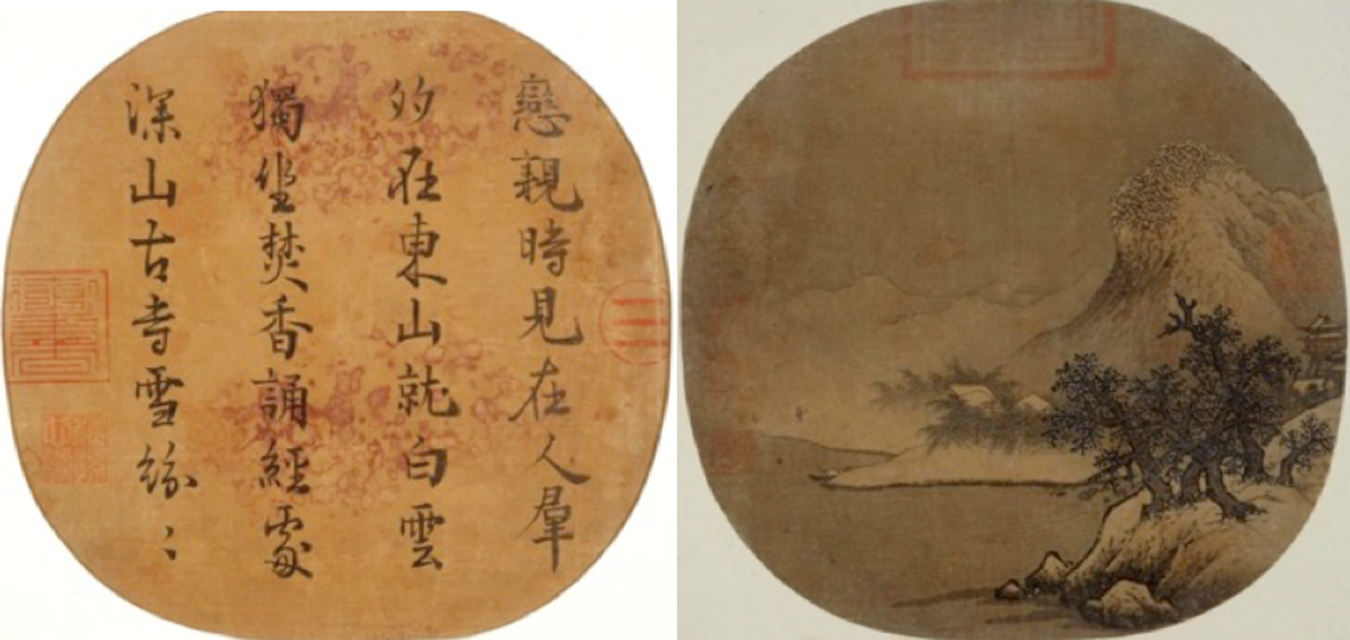
Figure 15. Right: Li Dong 李東 (act. 1210–1261), Temple Among Snowy Hills 雪山蕭寺圖團扇. Fan, ink on silk, 24.7 × 25.2 cm. Museum of Fine Arts, Boston. Left: Emperor Lizong (r. 1224–1264), Calligraphy of a Poem by Huangfu Ran 書皇甫冉七絕團扇. Fan, ink on silk, 24 × 25.6 cm. Museum of Fine Arts, Boston
The Outsider Advantage: Benefits, Career Support, and Artistic Training
The brushwork of freelancers Xu Que, Li Dong, and Chen Qingbo was as accomplished as that of privileged court painters. Why, then, did they remain outsiders? One possible benefit of freelancing was that they could rely on the legal protection offered by profession-based hang guilds in Lin'an. At least 414 hang guilds existed in the capital streets, including highly specialized guilds for “Painted Silk Fans” and “Painted Paper Fans.”Footnote 64 The assorted fan guilds became commercial painters’ allies, new hubs enabling individuals to obtain contracts from the imperial court.
The emperor, instead of imposing service levies on freelance painters, normally dispatched the Lin'an prefectural government (or Ministry of Work) for acquisitions. For this purpose, the Lin'an government appointed brokers (ya 牙) as official coordinators to communicate with commercial guilds.Footnote 65 Some of these brokers in the “Office for Furniture Arrangement” 帳設司 were tasked with buying art commodities for royal needs.Footnote 66
In a thriving free market, brokers and guilds formed important intermediaries between the Lin'an court and freelance craftsmen, overseeing market prices and logistic rules. By helping the latter to contract with the court and regulating the commission fees, guilds performed dual functions for the two parties: speeding up imperial exactions as well as spreading out beneficial commissions.
Freelance painters in Lin'an could sell their art to the court through mutual agreements, known as hegu employment or hemai 和買 (consensual procurement).Footnote 67 They could theoretically decline imperial acquisitions at their own discretion, as conveyed by the combination of the characters he (agreement), gu (hire), and mai (buy). A bolt of hemai silk serves as an example: its market prices fluctuated between 6,000–7,000 coins. The government prepaid silk suppliers 6,500 coins as hemai money before receiving the ordered goods.Footnote 68 If the court decreased its budget for hegu, guilds in Lin'an could have authority to adjudicate the hegu prices, thereby protecting freelancers from imperial extortions:
The Crafts Institute pay hegu money to highly skilled craftsmen, who produced objects for imperial daily life. 文思院 … 和雇於高人匠造作生活.Footnote 69
Shops formed guilds in order to regulate governmental acquisitions … . Physicians, soothsayers, and laborers might be asked to offer services. Although they were hegu, the government would pay them more money and rice than private employers. Therefore, those who were summoned would have been delighted to be hegu
市肆謂之團行者, 蓋 因官府回買而立此名 … . 雖醫卜工役, 亦有差役. … 如官司和雇支給錢米, 反勝於民間 雇倩工錢, 而工役之輩, 則歡樂而往也.Footnote 70
Freelance painters in Lin'an elicited certain monetary advantages by not becoming court regulars. In Chen Qingbo's time, a bakery could earn 500 coins by selling just one butter cookie,Footnote 71 and the market price for a dan (approximately 50 kg) of rice was 3,000–3,400 coins.Footnote 72 While living expenses remained high, yuqian court painters were subjected to limited promotions (from 9b up to 8b rank) and official wages (7,000–17,000 coins yearly). In fact, freelancing was an attractive alternative for some court painters, who had the leeway to quit their insider status by abandoning their golden belt at the court, as demonstrated by the case of yuqian painter Liang Kai.Footnote 73 Even after Liang's exodus, disciples continued studying under him.Footnote 74
From the freelancer Xu Que's perspective, being an outsider did not impede him from building an empire-wide reputation. Accepting a hegu offer from the court empowered him to boost his income and profile, which would have been a calculated marketing move. Southern Song accounts chronicle how individuals once summoned by the monarch could thereafter expand their marketability.Footnote 75 Their outsider status, in return, provided them a perfect excuse to evade imperial monopoly and obligations.
How did these outsiders acquire artistic training? Since both new and ancient pieces were available in painting shops, which provided gallery-like environments, freelancers working at antique stores may have been drawn to archaic styles. In Li Dong's fans (Figure 15), the bare trees on snow-covered mountains derived from the work of the Northern Song landscapist Fan Kuan 范寬 (act. 960–1030), two centuries prior to Li's time and therefore no longer threatening Li's business. Equally traditional, Chen Qingbo may have acquired his training at a shop selling old-fashioned art. The early Southern Song freelancer Zhao Yan's fans from the 1130s were characterized by hesitant brushwork, bird's-eye perspectives, and landscape themes, which were embraced by Chen. The latter might also have studied the works of the court painter Yan Ciping (Figure 16) or his brother Ciyu, though Chen reduced the Yan brothers’ painstaking ink textures to light color wash. In Chen's Spring Dawn, the aerial perspective, short pine needles, and tangling thin vines resonate with Yan's manner (Figure 16). Rock surfaces were lightly swept on with a new brush, reminiscent of the delicate hand movements of the Yan brothers. The Yan brothers were approximately 50–60 years older than Chen.Footnote 76 Although determining whether Chen was a Yan pupil is impossible, their stylistic affinity implies that Chen may have learned more from bygone generations than from his contemporary court colleagues.

Figure 16. Left: Details of Chen Qingbo's workshop products. Right: Yan Ciping 閻次平 (court painter 1162–1180s), Villa Among Pines by River 松磴精廬圖. Signature: “Yan Ciping.” Fan, ink and colors on silk, 22.6 × 22.6 cm. National Palace Museum, Taipei
Freelancers probably also imitated unfinished sketches left by masters from any studio. Four sections of the unfinished Southern Song fenben or preliminary drafts, entitled Sketches from Life, survive today, consisting of preparatory sketches of rocks and frisky animals.Footnote 77 One section shows two playful puppies circling each other (see upper-left image of Figure 17); similar iconography was recurrently adopted by middle-to-late Southern Song painters from different schools, as in the upper-right images of Figure 17. The intentionally incomplete drafts exemplify how teachers sketched silhouettes for practice and for tutorial purposes, and how such fenben manuals would have influenced later generations. Late Song freelancers, such as Chen, could have referred to early models left by the Yan studio. As a result of studying the simplified fenben outlines, which omit meticulous rock textures, Chen replaced Yan's assiduously textured ink rocks with a dash of color wash (Figure 4). The faster he painted, the more he could produce. His rendition of tree branches (Figure 16) is more succinct than that of the Yan brothers, and his rounded, low mountains (Figure 13) depart from the style of Yan and other court painters, who envisioned mountains with crystalized, steep peaks (Figure 17). In total, the multiple pedagogical options—family studios, fans exhibited in market stalls, and fenben manuals left by older generations—exemplify the wide range of sources freelancers could turn to in order to nurture their art.
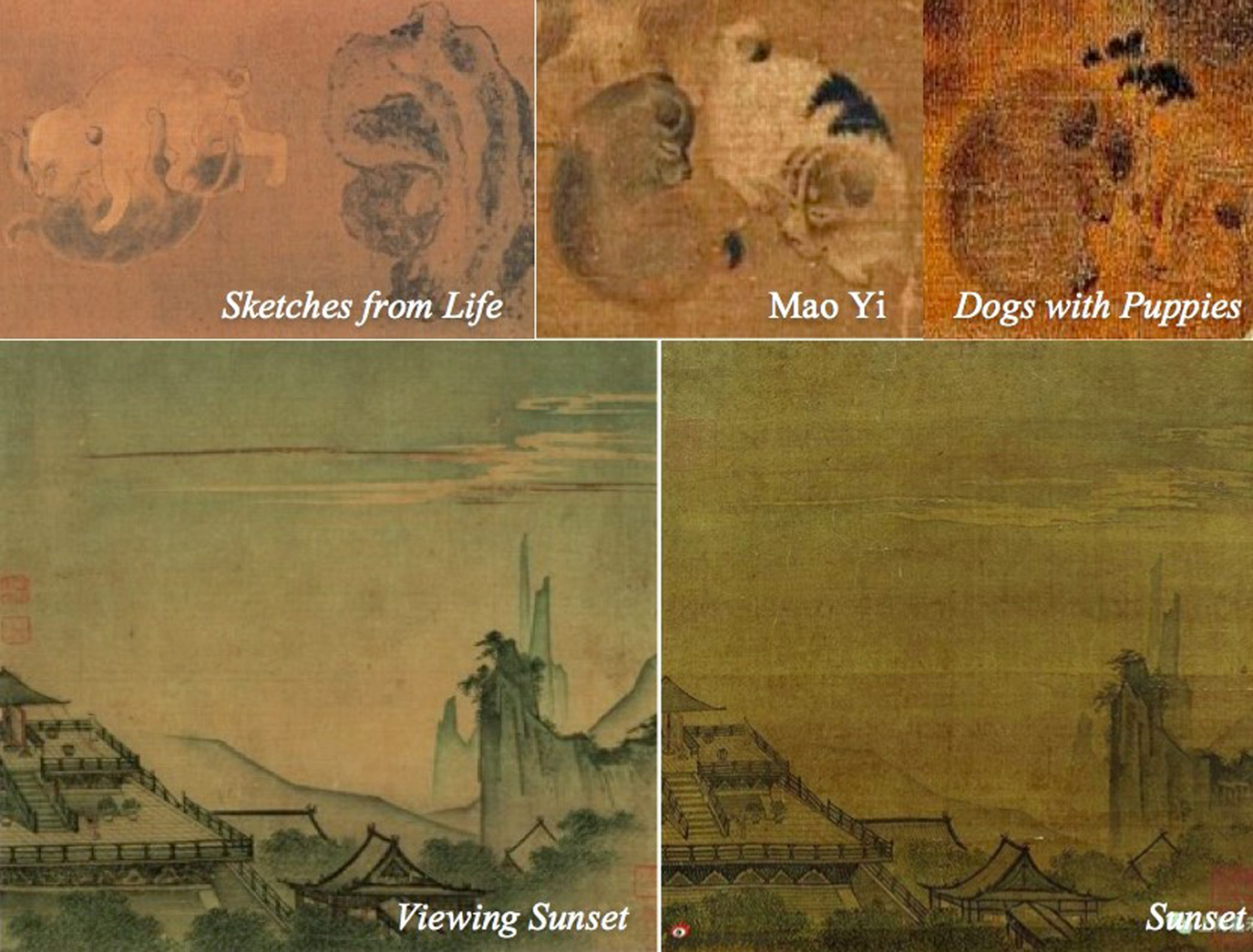
Figure 17. Upper left: Unsigned. Attributed to Ma Yuan 馬遠 (court painter 1190–1230), Sketches from Life 寫生四段圖卷. Handscroll, ink and colors on silk, 9.3 x 16.6 cm. Shanghai Museum. Upper middle: Mao Yi 毛益 (court painter 1165–1173), Daylilies and Dogs at Play 萱草游狗圖冊. Album leaf, ink and colors on silk, 25.3 x 25.7 cm. Yamato Bunkakan, Japan. Upper right: Anonymous, Dogs with Puppies in an Autumn Courtyard 秋庭乳犬圖團扇. Southern Song. Fan, color on silk, 24.1 x 25.2 cm. Shanghai Museum. Lower left: Anonymous, Viewing Sunset from a Palace Terrace 雕台望雲圖冊. Style after Ma Yuan. Album leaf, ink and colors on silk, 25 x 24 cm. Museum of Fine Arts, Boston. Lower right: Southern Song anonymous, Viewing Sunset. Album leaf, ink and colors on silk, 24 x 24 cm. Private collection, Shanghai
Thus far we have explored the benefits that lured freelancers to maintain their outsider status. They had more liberty to pick their career paths and to build unorthodox reputations. Yet the potential downside of this self-employed position demands equal attention. In Lin'an's fast and fickle market, how did they strive against their opponents, including court painters and other freelancers, to grow their own revenue? Why would Chen Qingbo tuck his signature twice onto a small fan, a double precaution that exposed his insecurity?
Freelancers’ Dilemmas: Plagiarizing, Contesting, and Double Signing
The aforementioned freelancers specialized in landscape (e.g. Zhao Yan, Wang Zongyuan, Li Dong, and Chen Qingbo) or figure genres (e.g. Chen Qingbo and Xu Que), popular themes appealed to the widest array of customers. According to Southern Song writers (e.g. Yue Ke) and modern scholars (e.g. Harrist, Weitz), fans in the Song were mostly merchandise, used for gift-giving and dispersing summer heat.Footnote 78 An emperor often bestowed thousands of painted landscape fans as gifts upon court officials on the Double Fifth festival.Footnote 79 An empress, says Zhou Mi, would include painted fans in her gift boxes for her family while visiting her natal home.Footnote 80 The ruling house requested numerous painted fans from the market.Footnote 81 Crowds also carried fans while attending annual feast days (e.g. the Lantern Festival).Footnote 82 The sheer number of painted fans needed signals that a fan shop may have hired helpers to replicate their own designs:Footnote 83
Day and night vendors crammed the main streets of Hangzhou … . [selling assorted types of fans, including] “watermarked paper fans,” “fans with floral patterns,” “fans with subtle fragrance” … . and other products for the four seasons. Customers could pre-order goods to satisfy their desires 夜市:杭城大街, 買賣晝夜不絕 … .漏塵扇柄、異色影花扇 … 藏香細扇 … . 及四時景物, 預行撲賣, 以為賞心樂事之需耳.Footnote 84
More than 300 practitioners set up stores along the Imperial Way … . either selling decorative screens or executing paintings. The pictorial subjects included figures with narrative stories, or deities and demons 御街應市, 兩岸術士有三百餘人設肆 … . 或為屏風, 或做畫, 或作故事人物, 或傀儡神鬼.Footnote 85
Nowadays more than ten thousand shops are open along the Imperial Way. Large and small, the shops do a vast amount of trade. For example, along the riverside of Pingjin Bridge are textile stores, fan shops, and Wenzhou-imported lacquer stores … . As for old mulberry paper and feather fans, each [type of commodity] has specific a hang guild 今于御街開張數鋪亦不下萬計. 又有大小鋪席, 皆是廣大物貨. 如平津橋沿河, 布舖, 扇鋪、溫州漆器鋪 … . 至於故褚羽毛扇牌, 皆有行舖.Footnote 86
Within a shop, apprentices assisted in completing projects for their boss, as evidenced by the inferiority of some of the work. In Water Village (Figure 7), the stiff brushwork and color possess a mediocre quality, possibly because the work was color-washed by a novice in Chen Qingbo's workshop.
How competitive was the fan market? A painting catalogue from 1167 recounts the rivalry among the fan shops:
Liu Zongdao (early twelfth century), a native of the capital … . Each time he designed a new fan, he painted several hundred replicas. Only then would he put the copies on sale, distributing them on the same day. [The reason was that] he feared someone else would start plagiarizing his design 劉宗道, 京師人 … . 每作一扇, 必畫數百本, 然後出貨, 即日流布, 實恐他人傳模之先也.Footnote 87
This passage suggests that commercial painters were not themselves a collegial alliance: they pirated each other's designs. Each fan shop kept its new iconographic repertoire secret to prevent plagiarism; once a design was invented, the shop would replicate this new motif hundreds of times before releasing the fans all together.
This mass production by coworkers in a shop explains why several Southern Song fans share a similar composition with analogous brushwork. For example, two anonymous paintings, Viewing Sunset from a Palace Terrace (Figure 17) and Viewing Sunset, adopted an identical configuration with equally exquisite quality, as if they were twin versions from the same company. Surviving twins or triplets like this compel us to ponder the current scholarship, which often divides twin versions into a binary category of either authentic or forged. In fact, I argue, a proportion of “sibling fans” might not be later forgeries, but instead were multiplied by Southern Song coworkers of a fan shop in order to maximize their profit. This challenging environment illuminates why Chen Qingbo seems to be unaffected by mainstream court painters. Chen probably considered Li Song, Ma Lin, and Xia Gui his competitors. To circumvent them, Chen leveraged the topography of the nearby Qingbo environment, using his home community as his artistic calling card.
The tension between different studios may clarify why Chen double-signed his fans, including Spring Dawn (Figure 4) and Palace Terrace (Figure 5), in both corners. The double signatures insist on Chen's authorship, serving as extra insurance in case one signature was erased or removed from the art. Since silk paintings could easily be detached from a fan and affixed to an album leaf or other media, the original signature could be easily trimmed away by mounters, or perhaps by Chen's rivals. Double signing sought to prevent identity theft and functioned as a message through which the painter endeavored to reassert his presence. This marketing strategy reveals that the doubly signed fans were not intended for the emperor, as the latter would have demanded a neat, polished picture without redundant signatures. When the monarch commissioned works by court painters like Ma Yuan, Ma Lin, Xia Gui, and Li Song, none of them signed their names twice. In that case, the painter would proudly inscribe his name with dark, large characters in a pronounced place and a valedictory closing, such as “your servitor, Ma Lin” in Figure 2.
While the artist-owner of a shop endeavored to keep his new designs secret, his sly clerks may have leaked his designs to his competitors. In other cases, the shopkeeper himself might hire specialists to ghost-paint particular motifs. A landscape painter who owned a shop might have entrusted an architectural expert to draw buildings, after which the boss might have added landscape background. The latter might also cunningly sign his name to claim his authorship over the collective effort, since he possessed the shop. The aforementioned Liang Kai's Frontispiece handscroll (Figure 3) visualizes workshop cooperation in a court-commissioned project. Multiple hands undertook a single painting, but who alone would sign his name? The supervisor, of course, the project leader and power player of his team.
Certainly, pupils trained by one school could jump from one company to another. The itinerants and collaborations across different workshops may explain why several extant Southern Song paintings bear traces from multiple schools. The background trees of Chen's Palace Terrace (Figure 5) typifies his temperament: descriptive and naturalistic. However, the female faces (Figure 18) are fastidiously precise, layer washed over iron-wire contours, in order to achieve a portrait-like exactitude. The perfection and realism exceeded Chen's technical capacity. Ladies’ poses, physiques, and gaits on this fan remind us of a court painter's work, Hitting the Ball in the Shadow of the Banana Leaves (Figure 19) attributed to Su Hanchen. Court painters like Su Hanchen, Chen Juzhong 陳居中 (act. 1160–1230; left images of Figure 18), and their trainees shone in realistically portraying court ladies. Were the female faces in Palace Terrace ghost-painted by someone from another workshop? We do not know, but the drapery outlines of a maid on an insignificant corner are hesitant, altered, and redrawn over a pre-existing thin line (cf. lower-right image of Figure 18). Judging from the faceless figures in the Spring Drawn (Figure 11), Water Village (Figure 9), and Long Bridge (Figure 11), as well as immature architectural outlines in Spring Dawn and Long Bridge, Chen's team, as landscapists, did not particularly excel at the anatomy of human faces and architecture. The Chen squad's overall technique is descriptive but not photographic. Since the diluted trees and thin drapery lines in Palace Terrace were consistent with his habitual style, one might wonder whether Chen, the supervisor of this project, might have hired a portrait specialist to draw the ladies. Afterwards Chen himself added the landscape background and signed his name twice for double insurance. These possibilities exemplify the various cooperative channels that enabled freelancers to learn from, and team up with, itinerant artists from other schools.

Figure 18. A comparison between Chen Qingbo's Palace Terrace and Chen Juzhong's 陳居中 (act. 1160–1230) Lady Wenji and Her Family 文姬圖冊. Fan, ink and colors on silk, 24.4 x 22.2 cm. Museum of Fine Arts, Boston.
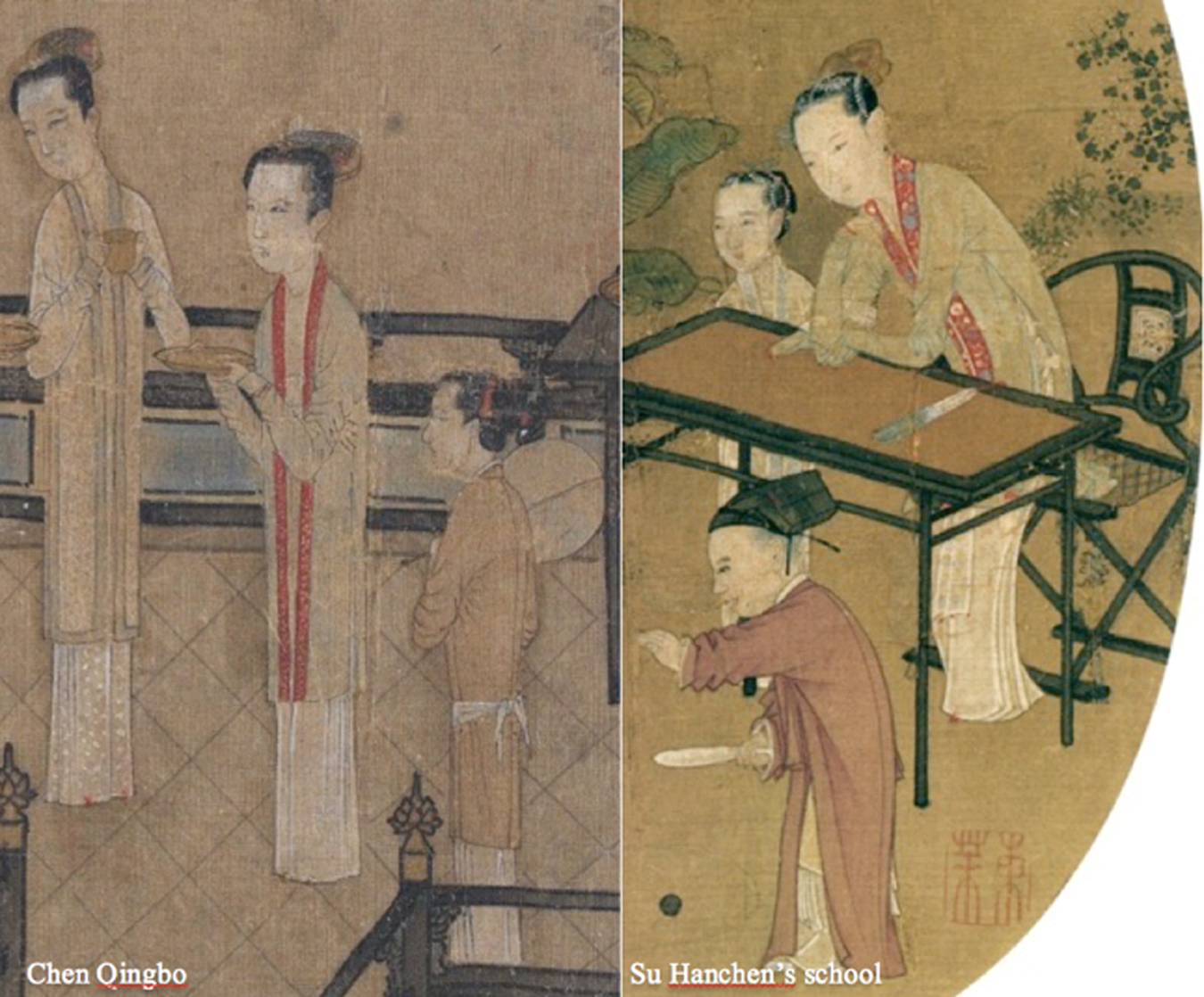
Figure 19. Left: Chen Qingbo's Palace Terrace. Right: Attributed to Su Hanchen 蘇漢臣 (court painter 1120s–1160s), Hitting the Ball in the Shadow of the Banana Leaves 蕉蔭擊球圖團扇. Unsigned but its label slip reads: “Su Hanchen.” Southern Song period. Ink and colors on silk, 25 x 24.5 cm. The Palace Museum, Beijing
Conclusion
This research maps the trajectory of art and contingent labor under Southern Song imperial control. I identify a hybrid class of freelance painters, who have been mischaracterized as court painters by post-Song historiographers, but who I argue instead made a living by operating fan shops to sell their paintings to consumers from all sociocultural strata. By uncovering the styles, career choices, artistic training, and court relationships of Chen Qingbo and other commercial painters (e.g. Zhao Yan, Xu Que, Li Dong), I conclude that a segment of freelancers received one-time contracts to paint for the court, although their names might not have been reported to the royal buyers.
The case of freelance painters epitomizes an important yet previously unstudied patron-client model exercised by the Southern Song court and its irregular contractors. The court, through the hegu and hemai systems, entrusted market agents to buy freelance products without letting the artists directly speak to the royal commissioners. Freelance painters in the marketplace could at will refuse to serve the court (Zhao Yan); remain connected with former court pupils after resigning their court-painter status (Liang Kai); or accept imperial summons to boost their income and artistic reputation (Xu Que). For legal protection they could join guilds, which in turn served as a go-between to serve the needs of royal families. As the imperial monopoly on artistic training decreased, freelancers acquired more practical and aesthetic autonomy than their court colleagues enjoyed. They sought to attract buyers with West Lake beauty, blissful iconographies, and pleasing, bright colors. Lin'an thus became a mercantile arena where painter-entrepreneurs strove to make a living.
While Lin'an experienced a surge of freelance painters, the court initiated a new system to license freelancers, reducing the size of its bureaucracy and maximizing efficiency. Court- and non-court painters, despite their diversity and occasional clashes, cohabitated in the same capital, where imperial and city buyers coalesced into a formidable demand for art. Working for the same clientele and sketching the same landscapes, painters surrounding the West Lake developed a holistic style. The purchasing power in Lin'an consolidated courtly and non-courtly products into a collective look, which nostalgic writers in subsequent dynasties would romanticize as “academic style.” In the eyes of post-1279 chroniclers, all capital painters retained a certain degree of cohesiveness, which has been perpetually misconstrued as the existence of a Southern Song painting academy. Finally, by decoding the use of freelance artists by the Southern Song government, I have found larger market forces in the political economy of this period, forging a dialogue among art historians, political and economic historians.Footnote 88






